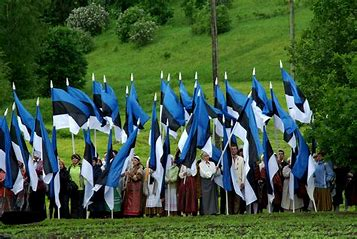Flying the tricolour
- bernienapp
- Feb 24
- 2 min read
Our family gave us each an Estonian flag and pennant. I am flying the lipp today at an event hosted by Estonia’s honorary consul, David Raudkivi, in Auckland - figuratively at least. 24 February is the date of the first independence, hard won, followed by an agonising loss, and then regained on 20 August 1991. A flag stands for something, for who we are as Estonians, whether in the old country, and many thousands of kilometres away on the other side of the world.
That Estonia can fly the flag reaffirms our country’s existence, on the third anniversary of the Russian invasion of Ukraine, with a peace deal on the horizon, however, what kind of peace deal.

Courtesy of Estonia’s Riigikantselei
Horizontally striped in cornflower-blue, black and white: blue symbolises hope for the future, also faithfulness; black is a reminder of the dark past to which Estonia shall not return, alternatively, the dark, fertile soil; and white, enlightenment and education, the snow in winter, and the birch tree or kask. That’s according to the Lonely Planet guide, which also says:
“Estonia’s tricolour dates back to 1881 when a theology student named Jaan Bergmann wrote a poem about a beautiful flag flying over Estonia. The only problem for both Jaan and his countrymen, was that no flag in fact existed.”
Incredible, really. It proves the truth of Albert Einstein’s quote, “imagination is more important than knowledge”. The courage and conviction of those leading the national awakening defies description.
Twenty Tartu university students decided on the colours in September 1881; however, three years passed before the Beermann sisters “sewed together a large flag made of silk”. A student procession took the new flag to Otepää, and dipped it in the the puhajärv, the holy lake, to consecrate it, and then hid it in the student archive.
The flag spread, in hiding, made its public appearance during the first independence, vanished from view during the dark years of the Cold War, and reappeared again in 1991. We knew of the flag, of course, as children in faraway New Zealand. Dad got one in 1988 when he attended the Estonian days in Australia that year. Our sister Cathi now has it, as the first Estonian in our generation to get a passport.
I raise a glass to the old country, say terviseks, and look my compatriots in the eye as a token of respect. This country at the edge of free Europe survives and thrives, after centuries of turmoil, and despite today’s geopolitics. As long as Estonians exist who live our culture and speak our language, Estonia will last, and long may that continue.
For my daughter, Olivia, the tricolour symbolises the national flower, the cornflower, or a clear sky on a winter’s day, the pine and spruce forests, and the snow, the promise of a white Christmas. I can only agree.







Comments